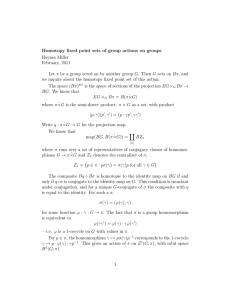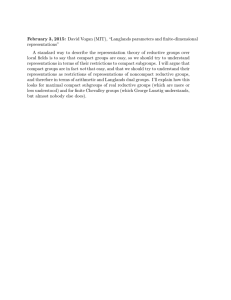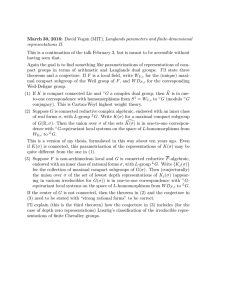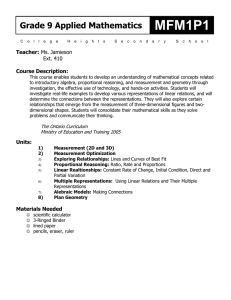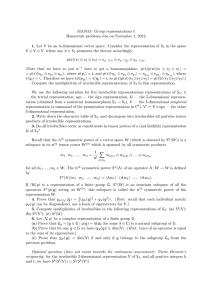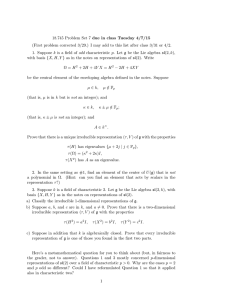Course 424 Group Representations Dr Timothy Murphy Sample Paper
advertisement
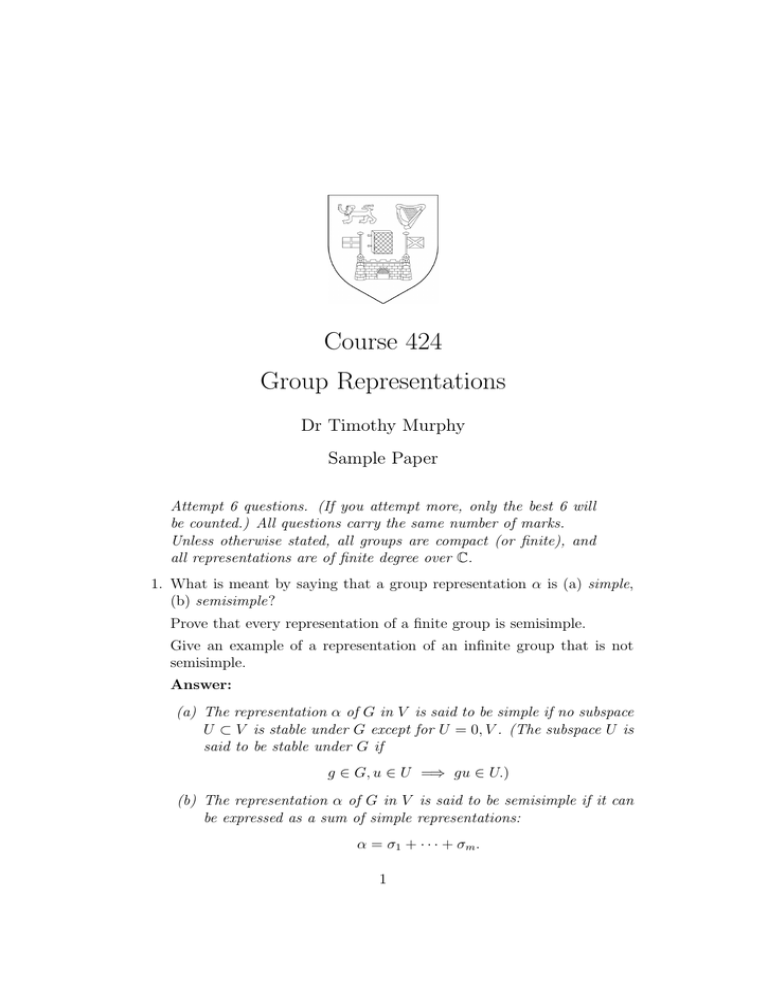
Course 424
Group Representations
Dr Timothy Murphy
Sample Paper
Attempt 6 questions. (If you attempt more, only the best 6 will
be counted.) All questions carry the same number of marks.
Unless otherwise stated, all groups are compact (or finite), and
all representations are of finite degree over C.
1. What is meant by saying that a group representation α is (a) simple,
(b) semisimple?
Prove that every representation of a finite group is semisimple.
Give an example of a representation of an infinite group that is not
semisimple.
Answer:
(a) The representation α of G in V is said to be simple if no subspace
U ⊂ V is stable under G except for U = 0, V . (The subspace U is
said to be stable under G if
g ∈ G, u ∈ U =⇒ gu ∈ U.)
(b) The representation α of G in V is said to be semisimple if it can
be expressed as a sum of simple representations:
α = σ1 + · · · + σm .
1
This is equivalent to the condition that each stable subspace U ⊂ V
has a stable complement W :
V = U ⊕ W.
(c) Suppose α is a representation of the finite group G in the vector
space V . Let
P (u, v)
be a positive-definite hermitian form on V . Define the hermitian
form Q on V by
Q(u, v) =
1 X
H(gu, gv).
kGk g∈G
Then Q is positive-definite (as a sum of positive-definite forms).
Moreover Q is invariant under G, ie
Q(gu, gv) = Q(u, v)
for all g ∈ G, u, v ∈ V . For
1 X
H(ghu, ghv)
kGk g∈G
1 X
=
H(gu, gv)
|G| g∈G
Q(hu, hv) =
= Q(u, v),
since gh runs over G as g does.
Now suppose U is a stable subspace of V . Then
U ⊥ = {v ∈ V : Q(u, v) = 0 ∀u ∈ U }
is a stable complement to U .
Thus every stable subspace has a stable complement, ie the representation is semisimple.
(d) The representation α of Z of degree 2 over C given by
1 n
n 7→
0 1
is not semisimple.
For the representation is not simple, since it leaves stable the 1dimensional subspace hei, where
1
e=
.
0
If α were semisimple, say α = β + γ, where β, γ are of degree 1,
then α(n) would be diagonalisable for all n.
Since α(n) has eigenvalues 1, 1, this implies that
α(n) = I
for all n, which is not the case.
2. Draw up the character table for S4 .
Determine also the representation-ring for S4 , ie express the product
αβ of each pair of simple representations as a sum of simple representations.
Draw up the character table for the subgroup A4 of even permutations.
Answer:
(a) S4 has 5 classes, corresponding to the types 14 , 12 2, 13, 22 , 4. Thus
S4 has 5 simple representations.
Each symmetric group Sn (for n ≥ 2) has just 2 1-dimensional
representations, the trivial representation 1 and the parity representation .
Let S4 = Perm(()X), where X = {a, b, c, d}. The action of S4 on
X defines a 4-dimensional representation ρ of S4 , with character
χ(g) = |{x ∈ X : gx = x}|
In other words χ(g) is just the number of 1-cycles in g.
So now we can start our character table (where the second line
gives the number of elements in the class):
14 12 2 13 22 4
(1) (6) (8) (3) (6)
1 1
1
1
1
1
1 −1 1
1 −1
ρ 4
2
1
0
0
Now
1
(1 · 16 + 6 · 4 + 8 · 1) = 2.
24
It follows that ρ has just 2 simple parts. Since
I(ρ, ρ) =
I(1, ρ) =
1
(1 · 4 + 6 · 2 + 8 · 1) = 1,
24
It follows that
ρ = 1 + α,
where α is a simple 3-dimensional representation, with character
given by
χ(g) = χρ (g) − 1.
The representation α is also simple, and is not equal to α since
it has a different character. So now we have 4 simple characters
of S4 , as follows:
14
(1)
1 1
1
α 3
α 3
12 2 13 22 4
(6) (8) (3) (6)
1
1
1
1
−1 1
1 −1
1
0 −1 −1
−1 0 −1 1
To find the 5th simple representation, we
has character
14 12 2 13 22
(1) (6) (8) (3)
2
α
9
1
0
1
can consider α2 . This
4
(6)
1
We have
1
(9 + 6 + 3 + 6) = 1,
24
1
I(, α2 ) = (9 − 6 + 3 − 6) = 0,
24
1
I(α, α2 ) = (27 + 6 − 3 − 6) = 1,
24
1
1
I(α, α2 ) = (27 − 6 − 3 + 6) = 1.I(α2 , α2 ) = (81 + 6 + 3 + 6) = 4,
24
24
I(1, α2 ) =
It follows that α2 has 4 simple parts, so that
α2 = 1 + α + α + β,
where β is the 5th simple representation, with character given by
χβ (g) = χα (g)2 − 1 − χα (g) − (g)χα (g).
This allows us to complete the character table:
14
(1)
1 1
1
α 3
α 3
β 2
12 2 13 22 4
(6) (8) (3) (6)
1
1
1
1
−1 1
1 −1
1
0 −1 −1
−1 0 −1 1
0 −1 2
0
(b) We already know how to express α2 in terms of the 5 simple representations. Evidently β = β since there is only 1 simple representation of dimension 2. The character of αβ is given by
14 12 2 13 22 4
αβ 6 0
0 −2 0
We have
1
(36 + 12) = 2.
24
Thus αβ has just 2 simple parts. These must be α and α to give
dimension 6:
αβ = α + α.
I(αβ, αβ) =
Also we have
I(β 2 , β 2 ) =
1
(16 + 8 + 48) = 3.
24
Thus β has 3 simple parts. So by dimension, we must have
β 2 = 1 + + β.
Now we can give the multiplication table for the representationring:
1 β
α
α
1 1 β
α
α
1
β
α
α
β β β 1++β
α + α
α + α
α α α α + α 1 + β + α + α + β + α + α
α α α
α + α + β + α + α 1 + β + α + α
(c) Recall that an even class ḡ ⊂ Sn splits in An if and only if no odd
element x ∈ Sn commutes with g, in which case ḡ splits into two
classes of equal size.
There are 3 even classes in Sn : 14 , 22 and31, containing 1, 3, 8 elements, respectively. The first two cannot split, since they contain
an odd number of elements. The third class does split; for suppose
x commutes with g = (abc). Then
xgx−1 = (x(a), x(b), x(c)) = (a, b, c).
It follows from this that
x ∈ {1, g, g 2 }.
In particular, x is even.
Thus the class 31 splits into two classes 310 and 3100 , each containing 4 elements.
3. Show that the number of simple representations of a finite group G is
equal to the number s of conjugacy classes in G.
Show also that if these representations are σ1 , . . . , σs then
dim2 σ1 + · · · + dim2 σs = |G|.
Determine the degrees of the simple representations of S6 .
Answer:
(a)
(b)
(c)
(d) S6 has 11 classes:
16 , 214 , 22 12 , 23 , 313 , 321, 32 , 32 , 412 , 51, 6.
Hence it has 11 simple representations over C.
It has 2 representations of degree 1: 1 and the parity representation .
The natural representation ρ1 of degree 6 (by permutation of coordinates) splits into two simple parts:
ρ1 = 1 + σ1 ,
where σ1 is of degree 5.
If α is a simple representation of odd degree, then
α 6= α.
For a transposition t has eigenvalues ±1, since t2 = 1. Hence
χα (t) 6= 0.
But
χα (t) = χ (t)χα (t) = −χα (t).
Thus the simple representations of odd degree d divide into pairs
α, α. So there are an even number of representations of degree
d.
In particular there are at least 2 simple representations of degree
5: σ and σ.
We are going to draw up a partial character table for S6 , adding
rows as we gather more material.
16 214 22 12 23 313 321 32 42 412 51
# 1 15 45 15 40 120 40 90 90 144
ρ1 6
4
2
0
3
1
0
2
0
1
3
1 −1 2
0 −1 1 −1 0
σ1 5
ρ2 15 7
3
3
3
1
0
1
1
0
τ 14 6
2
2
2
0 −1 0
0 −1
3
1
3
0
0
0 −1 1 −1
σ2 9
ρ3 20 8
4
0
2
2
2
0
0
0
3 −1 1
1
1 −1 −1 −1
θ 19 7
σ3 5
1
1 −3 −1 1
2 −1 −1 0
2
σ1 25 9
1
1
4
0
1
1
1
0
φ 24 8
0
0
3 −1 0
0
0 −1
6
120
0
−1
0
−1
0
0
−1
0
1
0
Now consider the permutation representation ρ2 arising from the
action of S6 on the 15 pairs of elements. Evidently
I(ρ2 , 1) > 0,
since all the terms in the sum for this are ≥ 0. Let τ = ρ2 − 1.
Then
I(τ, τ ) =
1
(196 + 540 + 180 + 60 + 160 + 40 + 144 + 120) = 2,
720
while
I(τ, σ1 ) =
1
(70 + 270 + 90 − 30 + 160 + 40 + 120) = 1.
720
Thus
σ2 = τ − σ1
is simple.
So far we have 6 simple representations:
1, , σ1 , σ1 , σ2 , σ2 ,
of degrees 1,1,5,5,9,9.
Next consider the permutation representation ρ3 arising from the
action of S6 on the 20 subsets of 3 elements. Evidently
I(ρ3 , 1) > 0,
since all the terms in the sum for this are ≥ 0.
[Although not needed here, it is worth recalling that if ρ is a permutation representation arising from the action of G on the set
X then I(ρ, 1) is equal to the number of orbits of the action.]
Let θ = ρ3 − 1. Then
I(θ, θ) =
1
(361+735+405+15+40+120+40+90+90+144+120) = 3.
720
Thus θ has 3 simple parts.
Now
I(θ, σ1 ) =
1
(95 + 315 + 135 + 15 + 80 − 40 − 90 + 90 + 120) = 1,
720
while
I(θ, σ2 ) =
1
(171 + 315 + 135 − 45 + 90 − 90 + 144) = 1.
720
It follows that
σ3 = θ − σ1 − σ2
is simple.
Now we have 8 simple representations:
1, , σ1 , σ1 , σ3 , σ3 , σ2 , σ2 ,
of degrees 1,1,5,5,5,5,9,9.
We have 3 remaining simple representations. Suppose they are of
degrees a, b, c. Then
720 = 2 · 12 + 4 · 52 + 2 · 92 + a2 + b2 + c2
ie
a2 + b2 + c2 = 456.
Now
456 ≡ 0 mod 8.
If n is odd then n2 ≡ 1 mod 8. It follows that a, b, c are all even,
say
a = 2d, b = 2e, c = 2f,
with
d2 + e2 + f 2 = 114.
Since
114 ≡ 2 mod 8,
it follows that two of d, e, f are odd and one is divisible by 4. Let
us suppose these are d, e, f in that order. Then
f ∈ {4, 8}.
If f = 4 then
d2 + e2 = 98 =⇒ d = e = 7,
while if f = 8 then
d2 + e2 = 50 =⇒ d = e = 5.
So the three remaining simple representations have degrees
8, 14, 14 or 10, 10, 16.
Let
φ = σ12 − 1.
Then
I(φ, φ) =
1
(576 + 960 + 360 + 120 + 144) = 3.
720
Also
I(φ, σ1 ) =
1
(120 + 360 + 240) = 1,
720
I(φ, σ2 ) =
1
(216 + 360 + 144) = 1.
720
while
Thus
σ4 = φ − σ1 − σ2
is a simple representation of degree 10.
We conclude that the 11 simple representations have degrees
1, 1, 5, 5, 5, 5, 9, 9, 10, 10, 16.
4. Determine the simple representations of SO(2).
Suppose H is a subgroup of the compact group G of finite index. Explain how a representation β of H induces a representation β G of G.
Determine the simple representations of O(2).
Answer:
(a) Let
R(θ) ∈ SO(2)
denote rotation through angle θ. Then the map
R(θ) 7→ eiθ : SO(2) → U(1)
is an isomorphism, allowing us to identify SO(2) with U(1).
This group is abelian; so every simple representation α (over C)
is of degree 1; and since the group is compact
im α ⊂ U(1).
ie α is a homomorphism
U(1) → U(1).
For each n ∈ Z the map
E(n) : z → z n
defines such a homomorphism. We claim that every representation
of U(1) is of this form.
For suppose
α : U (1) → U (1)
is a representation of U(1) distinct from all the E(n).
Then
I(En , α) = 0
for all n, ie
1
cn =
2π
Z
2π
α(eiθ )e−inθ dθ = 0.
0
In other words, all the Fourier coefficients of α(eiθ ) vanish.
But this implies (from Fourier theory) that the function itself must
vanish, which is impossible since α(1) = 1.
(b) Suppose β is a representation of H in the vector space U .
Express G as a union of left H-cosets:
G = g1 H ∪ · · · ∪ gr H
Set
V = g1 U ⊕ · · · ⊕ gr U,
ie V is the direct sum of r copies of U , labelled by g1 , . . . , gr .
We define the action of g ∈ G on V as follows. Suppose 1 ≤ i ≤ r.
Then
ggi = gj h
for some j ∈ [1, r], h ∈ H.
We set
g(gi u) = gj (hu).
That defines the action of g on the summand gi U ; and this is
extended to V by linearity.
It is readily verified that this defines a representation of G in V ,
and that the choice of different representatives g1 , . . . , gr of the
cosets would lead to an equivalent representation.
(c) Since SO(2) is a subgroup of index 2 in O(2), the representation
E(n) of SO(2) = U (1) induces a representation
αn = E(n)O(2)
of O(2) of degree 2.
Any element of O(2) \ SO(2) is a reflection T (l) in some line l
through the origin. These reflections are all conjugate, since
R(θ)T (l)R(−θ) = T (l0 ),
where l0 = R(θ)l.
Also
T (l)R(θ)T (l) = R(−θ);
so the O(2)-conjugacy classes consist of pairs {R(±θ)}, together
with the set of all reflections.
Explicitly, on taking e, T e as basis for the induced representation
(where T is any reflection) we see that αn is given by
iθ
e
0
0 1
R(θ) 7→
, T (l) 7→
.
0 e−iθ
1 0.
If n 6= 0 this representation is simple. For
αn | SO(2) = E(n) + E(−n).
It follows that the only proper subspaces stable under SO(2) are
hei, hT ei, and these are not stable under T .
If n = 0 the representation splits into two parts:
α0 = 1 + ,
where
(R(θ)) = 1, (T (l) = −1,
ie (S) = ±1 according as S is proper or improper.
We claim that the simple representations of O(2) are precisely
these representations αn for n 6= 0, together with the representations 1, of degree 1.
For suppose α is a simple representation of O(2) in the vector
space V . Then
α| SO(2) = E(n1 ) + · · · + E(nr ),
ie V is the direct sum of 1-dimensional subspaces stable under
SO(2).
Let U = hei be one such subspace. Then U carries some representation E(n), ie
R(θ)e = einθ e
for all θ.
Take any reflection T . Then the subspace he, T ei is stable under
the full group O(2). Since α is simple,
V = he, T ei,
If n 6= 0 then we see explicitly that
α = αn .
If n = 0 then SO(2) acts trivially on U . If T e = e then U is 1dimensional, and α = 1. If not, then the 1-dimensional subspace
he − T ei carries the representation , and so α = .
We conclude that these are the only simple representations of
O(2).
5. Prove that SU(2) has one simple representation of each dimension
0, 1, 2, . . . .
Show that there exists a double covering Θ : SU(2) → SO(3).
Hence or otherwise determine the simple representations of SO(3).
Determine the representation-ring of SO(3), ie express the product of
each pair of simple representations as a sum of simple representations.
Determine the simple representations of O(3).
Answer:
(a) Suppose m ∈ N, Let V (m) denote the space of homogeneous polynomials P (z, w) in z, w. Thus V (m) is a vector space over C of
dimension m + 1, with basis z m , z m−1 w, . . . , wm .
Suppose U ∈ SU(2). Then U acts on z, w by
0
z
z
z
7→
=U
.
0
w
w
w
This action in turn defines an action of SU(2) on V (m):
P (z, w) 7→ P (z 0 , w0 ).
We claim that the corresponding representation of SU(2) — which
we denote by Dm/2 — is simple, and that these are the only simple
(finite-dimensional) representations of SU(2) over C.
To prove this, let
U(1) ⊂ SU(2)
be the subgroup formed by the diagonal matrices U (θ). The action
of SU(2) on z, w restricts to the action
(z, w) 7→ (eiθ z, e−iθ w)
of U(1). Thus in the action of U(1) on V (m),
z m−r wr 7→ e(m−2r)iθ z m−r wr ,
It follows that the restriction of Dm/1 to U (1) is the representation
Dm/2 | U(1) = E(m) + E(m − 2) + · · · + E(−m)
where E(m) is the representation
eiθ 7→ emiθ
of U(1).
In particular, the character of Dm/2 is given by
χm/2 (U ) = emiθ + e(m−2)iθ + · · · + e−miθ
if U has eigenvalues e±iθ .
Now suppose Dm/2 is not simple, say
Dm/2 = α + β.
(We know that Dm/2 is semisimple, since SU(2) is compact.) Let
a corresponding split of the representation space be
V (m) = W1 ⊕ W2 .
Since the simple parts of Dm/2 | U(1) are distinct, the expression
of V (m) as a direct sum of U(1)-spaces,
V (m) = hz m i ⊕ hz m−1 wi ⊕ · · · ⊕ hwm i
is unique.
It follows that W1 must be the direct sum of some of these spaces,
and W2 the direct sum of the others. In particular z m ∈ W1 or
z m ∈ W2 , say z m ∈ W1 .
Let
1
U=√
2
Then
1 −1
∈ SU(2).
1 1
1
z+w
z
7→ √
w
2 −z + w
under U . Hence
z m 7→ 2−m/2 (z + w)m .
Since this contains non-zero components in each subspace hz m−r wr i,
it follows that
W1 = V (m),
ie the representation Dm/2 of SU(2) in V (m) is simple.
To see that every simple (finite-dimensional) representation of
SU(2) is of this form, suppose α is such a representation. Consider its restriction to U(1). Suppose
α| U(1) = er E(r) + er−1 E(r − 1) + · · · + e−r E(−r)
(ei ∈ N).
Then α has character
χ(U ) = χ(θ) = er eriθ + er−1 e(r−1)iθ + · · · + e−r e−riθ
if U has eigenvalues e±iθ .
Since U (−θ) ∼ U (θ) it follows that
χ(−θ) = χ(θ),
and so
e−i = ei ,
ie
χ(θ) = er (eriθ + e−riθ ) + er−1 (e(r−1)iθ + e−(r−1)iθ ) + · · · .
It is easy to see that this is expressible as a sum of the χj (θ) with
integer (possibly negative) coefficients:
χ(θ) = a0 χ0 (θ)+a1/2 χ1/2 (θ)+· · ·+as χs (θ)
(a0 , a1/2 , . . . , as ∈ Z).
Using the intertwining number,
I(α, α) = a20 + a21/2 + · · · + a2s
(since I(Dj , Dk ) = 0). Since α is simple,
I(α, α) = 1.
It follows that one of the coefficients aj is ±1 and the rest are 0,
ie
χ(θ) = ±χj (θ)
for some half-integer j. But
χ(θ) = −χj (θ) =⇒ I(α, Dj ) = −I(Dj , Dj ) = −1,
which is impossible. Hence
χ(θ) = χj (θ),
and so (since a representation is determined up to equivalence by
its character)
α = Dj .
(b) We can identify SU(2) with the group
Sp(1) = {q ∈ H : |q| = 1}.
[If we regard H as a 2-dimensional vector space over C with basis
1, j:
(z, w) 7→ z + wj,
then multiplication on the right by a quaternion defines a C-linear
map, ie an element of GL(2, C).
Suppose q = a + bj ∈ Sp(1). Then
q −1 = q ∗ = ā − bj;
and multiplication on the right by q −1 gives the map
z + wj 7→ (āz + b̄w) + (−bz + aw)j,
ie
z
ā b̄
z
7→
.
w
−b a
w
Since
|q|2 = |a|2 + |b|2 ,
this establishes an isomorphism
ā b̄
q 7→
: Sp(1) → SU(2).]
−b a
Now let V denote the 3-dimensional real vector space of purely
imaginary quaternions
v = xi + yj + zk.
Evidently
q ∈ V ⇐⇒ q ∗ = −q.
It follows that if q ∈ Sp(1), v ∈ V then
(qvq ∗ )∗ = qv ∗ q ∗ = −qvq a st.
Hence
qvq ∗ = qvq −1 ∈ V.
Thus each q ∈ Sp(1) defines a linear map
Θ(q) : v 7→ qvq ∗ : V → V,
giving a homomorphism
Θ : Sp(1) → GL(3, R).
If v ∈ V then
|v| = vv ∗ = x2 + y 2 + z 2 .
Now
|Θ(q)v|2 = (qvq ∗ )(qva∗ )∗
= qvq a stqv ∗ q a st
= qvv ∗ q ∗
= vv ∗ qq ∗
= vv ∗
= |v|2 ,
since vv ∗ ∈ R. Thus Θ(q) preserves the form x2 + y 2 + z 2 . Hence
Θ(q) ∈ O(3).
Since Sp(1) ∼
= S 3 is connected, so is im Θ(q). Hence
Θ(q) ∈ SO(3),
giving a homomorphism
Θ : Sp(1) → SO(3).
We have
ker Θ = {q ∈ Sp(1) : qv = vq ∀v ∈ V }.
Since any quaternion is expressible as Q = t1 + v, with t ∈ R, v ∈
V . it follows that
ker Θ = {q ∈ Sp(1) : qQ = Qq ∀Q ∈ H}.
It is readily verified that
ZH = R = {t1 : t ∈ R}.
Hence
ker Θ = {±1}.
To see that Θ is surjective, ie im Θ = SO(3), we note that SO(3)
is generated by half-turns π(l) about an axis l. But it is readily
verified that if v is a unit vector along l then
Θ(v) = π(v),
since Θ(v) leaves l fixed, and
v 2 = −vv a st = −1,
and so
Θ(v)2 = I.
Hence Θ defines a 2-fold covering of SO(3).
(c) Suppose
θ:G→H
is a surjective homomorphism. Then a representation
α : H → GL(V )
of H in V defines a representation
αθ : G → GL(V ).
Furthermore, distinct representations of H give rise to distinct
representations of G; and the representation αθ is simple if and
only if α is simple, since a subspace U ⊂ V is stable under G if
and only if it is stable under H.
Conversely, a representation
β : G → GL(V )
arises from a representation of H in this way if and only if
ker θ ⊂ ker α;
and if it does so arise, it is from a unique representation of H.
In the present case this shows that a representation of SO(3) arises
from a representation α of SU(2) if and only if
α(−I) = 1.
Looking at the definition of Dj by the action of of SU(2) on the
space of homogeneous polynomials f (z, w) of degree 2j, we see that
f (−z, −w) = (−1)2j f (z, w).
Thus
Dj (−I) = 1 ⇐⇒ j is a half-integer.
We conclude that the simple representations of SO(3) are the representations D0 , D1 , D2 , . . . of degrees 1, 3, 5, . . . .
(d)
6. Define the Lie algebra L G of a linear group G, showing that it is
indeed a Lie algebra.
Determine the Lie algebras of SU(2) and SO(3), and show that they
are isomorphic.
Are the groups isomorphic?
Answer:
(a)
7. Define the exponential eX of a matrix X ∈ Mat(n, k), where k =
R, C or H.
Determine eX in each of the following cases:
0 1
0 -1
1
X=
, X=
, X=
1 0
1 0
0
1
1
,
X=
1
-1
Show that if X has eigenvalues λ, µ then eX has eigenvalues eλ , eµ .
Which of the above 4 matrices X are themselves expressible in the form
X = eY for some real matrix Y ? (Justify your answers in all cases.)
Answer:
(a) The exponention of a square matrix is defined by
eX = I + X +
(b)
1 2 1 3
X + X + ··· .
2!
3!
i. If
X=
0 1
1 0
then
X 2 = I,
and so
1
1
1
1
+ + · · · )I + ( + + · · · )X
2! 4!
1! 3!
= cosh(1)I + sinh(1)X
cosh 1 sinh 1
=
sinh 1 cosh 1
eX = (1 +
ii. If
X=
0 −1
1 0
then
X 2 = −I,
and so
1
1
1
1
+ − · · · )I + ( − + · · · )X
2! 4!
1! 3!
= cos(1)I + sin(1)X
cos 1 − sin 1
=
sin 1 cos 1
eX = (1 −
1
1
.
iii. If
X=
1 1
= I + Y,
0 1
where
Y =
0 1
0 0
then
Y 2 = 0 =⇒ eY = I + Y = X,
and so
eX = eI eY
e e
=
0 e
iv. If
X=
1 1
= I − Y,
−1 1
where
Y =
then
Y
e =
0 −1
1 0
cos 1 − sin 1
sin 1 cos 1
from above, and so
−Y
e
Y −1
= (e )
=
cos 1 sin 1
− sin 1 cos 1
and
eX = eI e−Y
e cos 1 e sin 1
=
.
− sin 1 e cos 1
(c) [Note that this part of the question only makes sense if k = R or C.
One does not in general speak of the eigenvalues or eigenvectors
of a matrix X over H, since the solutions of Xv = qv will not in
general form a subspace over H.]
Since eX is the same whether we consider X as a real or complex
matrix, we may assume that X ∈ Mat(n, C).
We know that in this case X can be triangulated, ie we can find
T such that
λ c
−1
T XT =
0 µ
But then
r
λ cr
r −1
TX T =
0 µr
for each r, and so
λ 0
e c
X −1
Te T =
0 eµ
Since Y and T Y T −1 have the same eigenvalues, it follows that eX
has eigenvalues eλ , xµ .
(d) i. From the last result,
det eX = eλ eµ
= eλ+µ
= etr X .
In particular,
det eY > 0
for all real Y .
Since
det X = −1
in this case,
X 6= eY .
ii. The map
x + iy 7→
x −y
y x
: C → Mat(2, R)
is a homomorphism of R-algebras under which
z 7→ X =⇒ ez 7→ eX .
The matrix
0 −1
X=
1 0
corresponds to the complex number i.
But i = ez where z = π/2i. Thus X = eY where
0 −π/2
Y =
.
π/2
0
iii. We saw that
X = eY
in this case.
iv. As in the second case, the matrix X corresponds to the complex number
√
1 − i = 2e−iπ/4 .
Thus 1 − i = ez where
z = log 2/2 − iπ/4.
Hence X = eY , with
Y =
log 2/2 π/4
.
−π/4 log 2/2
8. Show that the connected component G0 of a linear group G is given by
G0 = {eX1 eX2 · · · eXr }
(X1 , X2 , . . . , Xr ∈ L G),
where r = 1, 2, . . . .
Explain how a representation α of a linear group G defines a representation L α of L G, and show that if G is connected then
L α = L β =⇒ α = β.
Sketch the proof that if G is simply connected then every representation
of L G arises from a representation of G.
Answer:
(a) It is clear that G0 is closed under multiplication; and it is closed
under inversion, since
(eX1 · · · eXr )−1 = e−Xr · · · e−X1 .
Hence G0 is a subgroup.
Also, G0 is connected, since
T (t) = etX1 · · · etXr
is a path connecting I to eX1 · · · eXr .
(0 ≤ t ≤ 1)
Finally, G0 is open. For there exists an open subset U 3 0 in L G
which is mapped homeomorphically onto an open subset V = eU 3
I in G; and
eX1 · · · eXr eU
is an open neighbourhood of eX1 · · · eXr .
Since G0 is an open subgroup, it is also closed; so G0 and its
complement are both open, and G0 is the connected component of
I in G.
(b) We assume the following result:
Lemma 1 Suppose
F :G→H
is a continuous homomorphism of linear groups. Then there is a
unique Lie algebra homomorphism
f : LG → LH
such that
F (eX ) = ef (X)
for all X ∈ L G.
Now suppose
α : G → GL(V )
is a representation of G.
By the Lemma, this gives rise to a Lie algebra homomorphism
L α : L G → gl(V ),
ie a representation of the Lie algebra L G in V , such that
α(eX ) = eL α(X)
for all X ∈ L G.
(c) Suppose
L α = L β = f,
say; and suppose T ∈ G. Then
T = eX1 · · · eXr ,
since G0 = G. Hence
α(T ) = α(eX1 ) · · · α(eXr )
= ef X1 · · · ef Xr
= β(eX1 ) · · · β(eXr )
= β(T ).
Thus
α = β.
(d) Suppose G, H are linear groups; and suppose the Lie algebra homomorphism
f : LG → LH
can be lifted to a homomorphism
F : G → H,
satisfying
F (eX ) = ef X
for all X ∈ L G.
If
eX1 · · · eXr = 1
is an ‘exponential relation’ in G, then
ef X1 · · · ef Xr = F (eX1 ) · · · F (eXr )
= F (eX1 · · · eXr )
=1
in H. Thus
eX1 · · · eXr = 1 =⇒ ef X1 · · · ef Xr = 1.
Conversely if this is so, ie every exponential relation in G maps to
a corresponding relation in H, then the required homomorphism
F : G → H can be defined as follows: given T ∈ G, suppose
T = eX1 · · · eXr .
Then we set
F (T ) = ef X1 · · · ef Xr .
It follows at once from the hypothesis that F (T ) is well-defined,
ie independent of the ‘exponential product’ we choose for T , and
that F is a homomorphism with L F = f .
i. This property always holds locally: if all the partial products
T = eX1 , eX1 eX2 , eX1 eX2 eX3 , . . .
lie in the logarithmic zone U then the corresponding relation
in H holds.
It is sufficient to prove this for ‘triangular relations’
eX eY eZ = 1.
This is established by showing that if X, Y, Z are small of size
d then the ‘discrepancy’
ef X ef Y ef Z − 1
is of order d3 .
Since a triangle of size d can be split into n2 triangles of size
d/n, it follows that the discrepancy of a triangle in U is in
fact 0.
ii. Now suppose G is simply connected, ie every loop is homotopically trivial.
9. Define the Killing form K(X, Y ) of a Lie algebra L .
Determine the Killing form of sl(2, R), and show that it is non-singular.
Show that if G is a compact linear group then the Killing form of G is
negative definite or indefinite.
Show conversely that if the Killing form a connected linear group G is
negative definite then G is compact. Is the condition of connectedness
necessary here?
Answer:
(a) The Killing form is the symmetric bilinear form
K(X, Y ) = tr(ad X ad Y ),
where ad X is the map
Z 7→ [X, Z] : L → L .
(b) We have
sl(2, R) = {X ∈ Mat(2, R) : tr X = 0}
= hH, E, F i,
where
H=
1 0
0 1
0 0
, E=
, F =
.
0 −1
0 0
1 0
Thus
[H, E] = HE − EH = 2E,
[H, F ] = HF − F H = −2F,
[E, F ] = EF − F E = H.
Now
ad H(H) = [H, H] = 0,
ad H(E) = [H, E] = 2E, ad H(F ) = [H, F ] = −2F,
ad E(H) = [E, H] = −2E, ad E(E) = [E, E] = 0,
ad E(F ) = [E, F ] = H,
ad F (H) = [F, H] = 2F,
ad F (E) = [F, E] = −H, ad F (F ) = [F, F ] = 0.
Thus ad H, ad E, ad F take matrix forms
0 0 0
0 0 1
0 −1 0
ad H 7→ 0 2 0 , ad E 7→ −2 0 0 , ad F 7→ 0 0 0
0 0 −2
0 0 0
2 0 0
with respect to the basis H, E, F of sl(2, R).
Hence
K(H, H) = tr((ad H)2 ) = 8,
K(E, E) = tr((ad E)2 ) = 0,
K(F, F ) = tr((ad F )2 ) = 0,
K(H, E) = tr(ad H ad E) = 0,
K(H, F ) = tr(ad H ad F ) = 0,
K(E, F ) = tr(ad E ad F ) = 4.
Thus the Killing form (with respect to the basis H, E, F ) is given
by the quadratic form
K(x, y, z) = K(xH + yE + zF, xH + yE + zF ) = 8x2 + 8yz,
which is non-singular (but neither positive nor negative).
(c) Suppose G is compact.
The adjoint representatiion of G in L G is given by
ad g(X) = gXg −1 .
Since G is compact, there is an positive-definite quadratic form
left invariant under this action. Choose coordinates so that this
form is
x21 + · · · + x2n .
Then
ad g ∈ O(n).
This representation of G corresponds to the adjoint representation
of L G:
ad X(Z) = [X, Z].
It follows that
ad X ∈ o(n) = {S ∈ Mat(n, R) : S + S 0 = 0}.
But then if ad X = S
(ad X)2 = −S 0 S,
and so
tr((ad X)2 ) = − tr(S 0 S) ≤ 0,
with equality only if S = 0.
We conclude that K(X, Y ) is negative definite or indefinite.
(d) If the Killing form K(X, Y ) of a linear group G is negative-definite
then it does follow that G is compact. The proof is long, and the
following is more of an overview. [A complete proof can be found
in Chapter 12 of Part IV of my notes.]
We assume the following result:
Lemma 2 The Killing form of a compact group G is left invariant by G:
K(ad g(X), ad g(Y )) = K(X, Y ).
If the Killing form is negative-definite, we can choose coordinates
so that it takes the form
−(x21 + · · · + x2n ).
Thus if we set
G1 = im Ad,
then
G1 ⊂ O(n).
[In fact, since G is connected,
G1 ⊂ SO(n).]
Now
ker Ad = ZG,
the centre of G. This is discrete; for
L (ZG) = Z(L G) = 0,
since
X ∈ ZG =⇒ ad X = 0
=⇒ K(X, Y ) = 0
for all Y ∈ L G, in which case the Killing form will be singular.
Thus
Ad : G → G1
is a covering.
A compactness argument shows that ZG is finitely-generated. If
it is finite we are done; it is easy to see that G is compact. If not
then ZG is an infinite discrete abelian subgroup; Thus
ZG = T ⊕ Zn
where T is finite and n > 0.
In particular, there is a non-trivial homomorphism
χ : ZG → R.
We are going to show that this can be extended to a homomorphism
X : G → R.
This will lead to a contradiction. For the kernel of the corresponding Lie algebra homomorphism will be an (n − 1)-dimensional subspace of L G; and it is easy to see that this subspace would in fact
be an ideal, whose complement with respect to the non-singular
Killing form would be a 1-dimensional ideal I ⊂ L G. This would
necessarily be trivial, so that K(X, Y ) = 0 for all X ∈ I, Y inL G,
contradicting the assertion that K(X, Y ) is negative-definite.
To construct the extension X, we note first that a standard compactness argument shows we can find a compact subset C ⊂ G
such that
Ad(C) = G1 .
Now let u(x) be a function on G with compact support such that
x ∈ C =⇒ u(x) > 0.
Set
u(x)
z∈ZG u(zx)
w(x) = P
Then
X
w(x) > 0 and
w(zx) = 1
z∈ZG
for all x ∈ G. (We can think of w(x) as a kind of weight on G,
allowing us to smooth out the given homomorphism χ.)
Set
X
w(zx)χ(z).
f (x) =
z∈ZG
0
Suppose z ∈ ZG. As z runs over ZG, so does zz 0 . Hence
X
f (x) =
w(zz 0 x)χ(zz 0 )
z∈ZG
=
X
w(zz 0 x)(χ(z) + χ(z 0 ))
z∈ZG
= f (z 0 x) + χ(z 0 ).
In other words,
f (zx) = f (z) − χ(z).
Thus if we define the function F : G × G → R by
F (x, y) = f (xy) − f (x),
then
F (zx, y) = F (x, y).
But that means we can regard F as a function on G1 × G, where
G1 = G/ZG is compact. This allows us to integrate over G1 , and
set
Z
X(g) =
F (g1 , g).
G1
It is a straightforward matter to verify that this function X : G →
R is in fact a homomorphism extending χ.
[This is a very complicated argument. Hopefully nothing as horrid
as this will be asked in the exam!]

